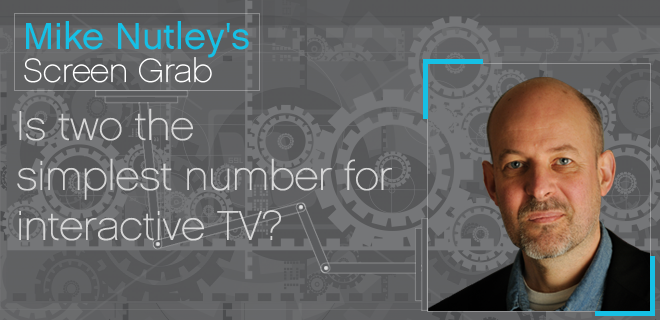
Interviewing Ernesto Schmitt of Zeebox for the previous Screen Grab, I was struck by what he said about media buying becoming more complicated, because of the need to identify the multiple user journeys on the second screen. What made me pause was not the idea of multiple user journeys themselves, but the question of how many of those journeys might be represented in any given sitting room.
This seems to me to be one of the major questions as we think about the next phase of interactive TV. When I first started writing about interactive media, back in 2000, the accepted model for interactive TV was just changing from dual-screen to single-screen. The early experiments had involved a TV and a computer, with the viewer switching their attention between them, but this model was being replaced by the red button. And this swing from dual to single screens and back again has continued since then.
In recent years, the rise of in-home wifi, cheap laptops (and subsequently tablets), and social media led to the current model of dual-screen interactive TV, which in its turn is being threatened by the advent of connected TVs. What’s interesting is that the recent boom in dual-screening was really an accident, caused by the coming together of a number of technological and commercial factors to meet consumer needs, principally the desire to find out more about what’s happening on-screen and to talk about it with your friends (Kevin Slavin of US social TV company Starling is fantastically good on the evolution of the shared entertainment experience).
The development of connected TV feels to me much more technocratic. According to Giles Warner of Deloittes at the recent Adobe Summit, most living rooms now have more computers than cushions, so the driver behind connected TV can hardly be that people need another one. And if you really want to watch YouTube on a 60-inch screen, the right cables aren’t that hard to find.
So connected TV feels like it’s happening because it can, rather than because there’s a consumer need to be filled. And because the internet has made it explicit that the number of user journeys around a piece of TV content is pretty much the same as the number of people in the room watching that content, the idea of cramming all those journeys back into the same box seems like a step backwards.
That’s not to say that there won’t be all sorts of unexpected use-cases for connected TV. As William Gibson once pointed out, you only really see what people are going to do with an emergent technology once they get their hands on it and use it on a daily basis.
It’s also worth bearing in mind the seemingly paradoxical idea that behaviours around media are changing all the time, but also not changing very quickly. Social media has upended broadcasters’ thinking by showing that drama can be event TV, not because of the content, but because of the conversation going on around it. But another thing revealed by Deloittes’ research is the reassurance viewers get from the TV schedule, with the company predicting 95% of TV will continue to be watched as scheduled.
It’s entirely possible that connected TV might be the first emergent technology that resonates more with a conservative audience than with early adopters. Looking at Schmitt’s five use cases for the second-screen, however – discovery, social interaction, information, play-along and commerce – it’s hard to see any of them sitting comfortably on the first screen, since what they all depend on is personalisation. That’s one trend that shows no sign of reversing, and it suggests that connected TV’s problem might be that it violates Albert Einstein’s famous dictum that everything should be as simple as possible, and no simpler.
 |
AdMonsters Screens unites the digital media leaders responsible for building the revenue engines of the multi-screen web. Register your place today and join Zeebox and others participating in the space in London on November 28 2012. |